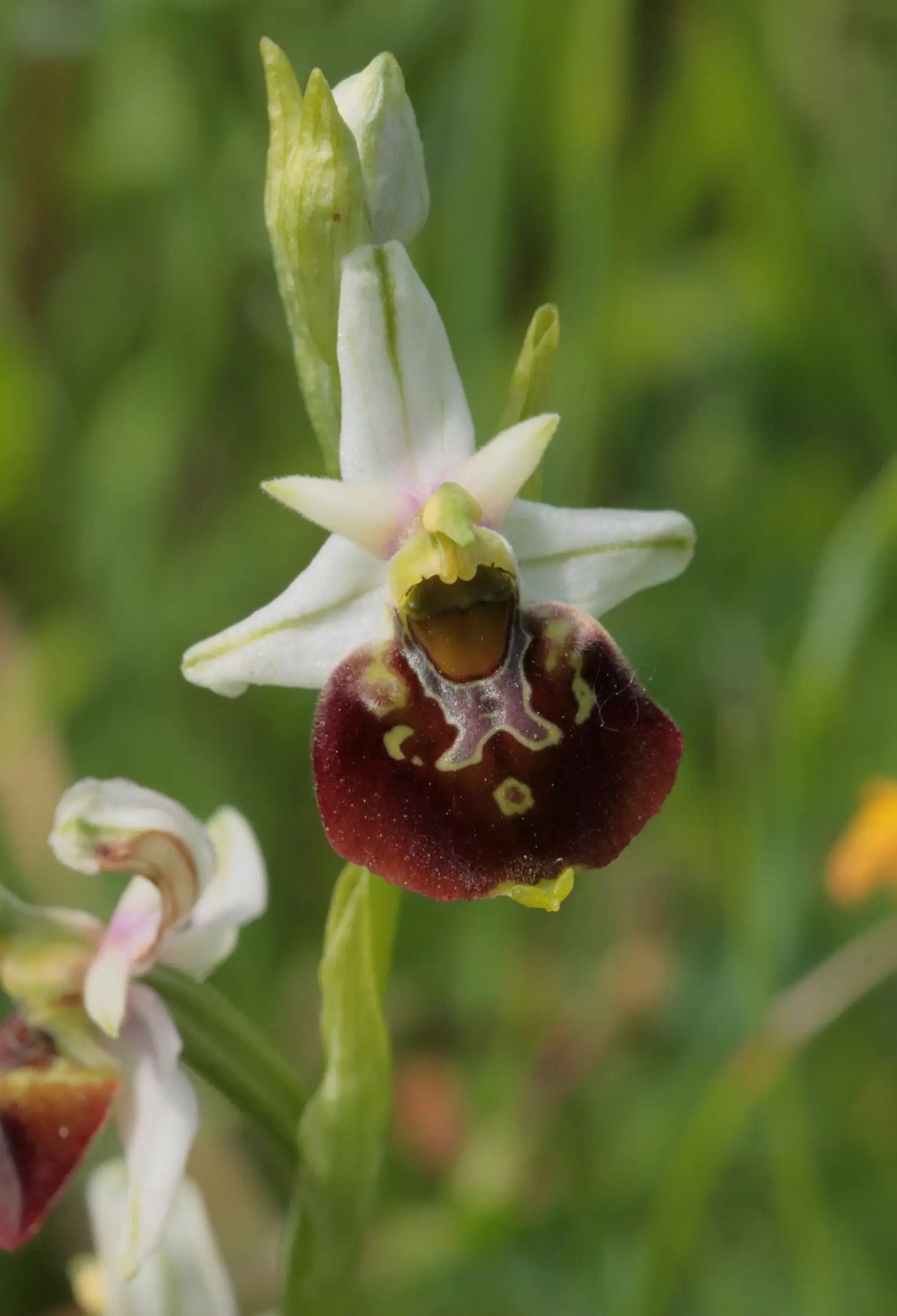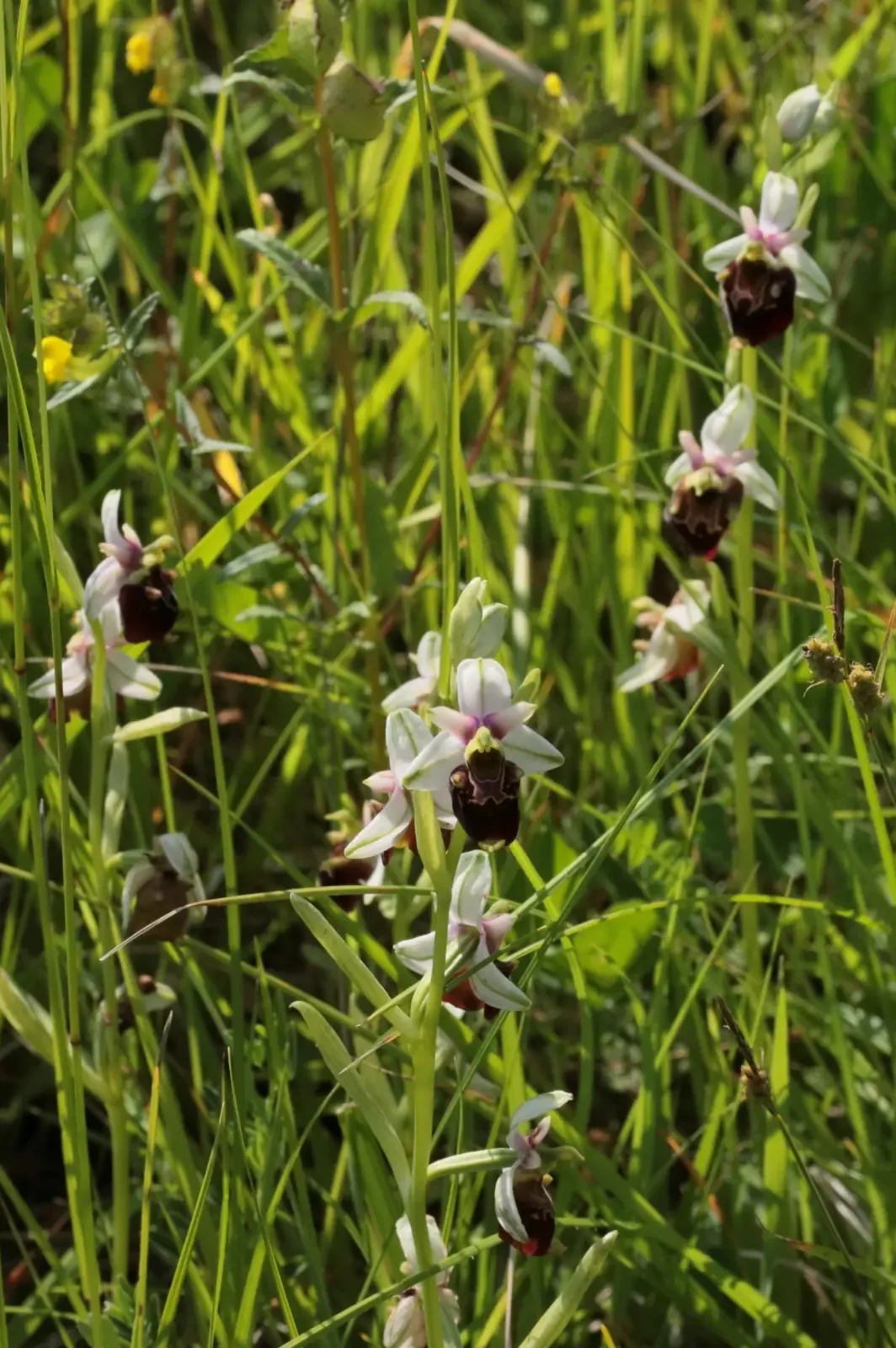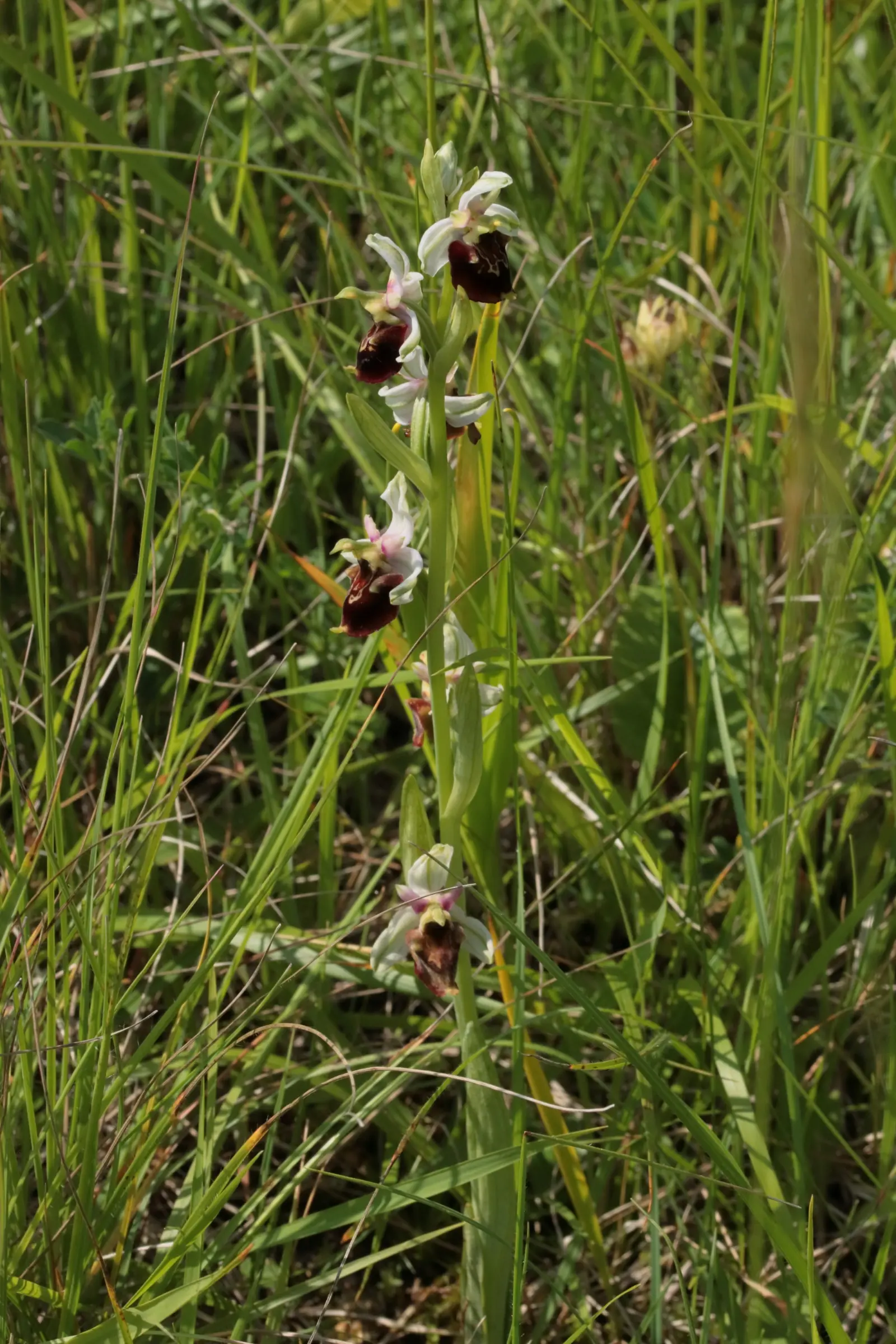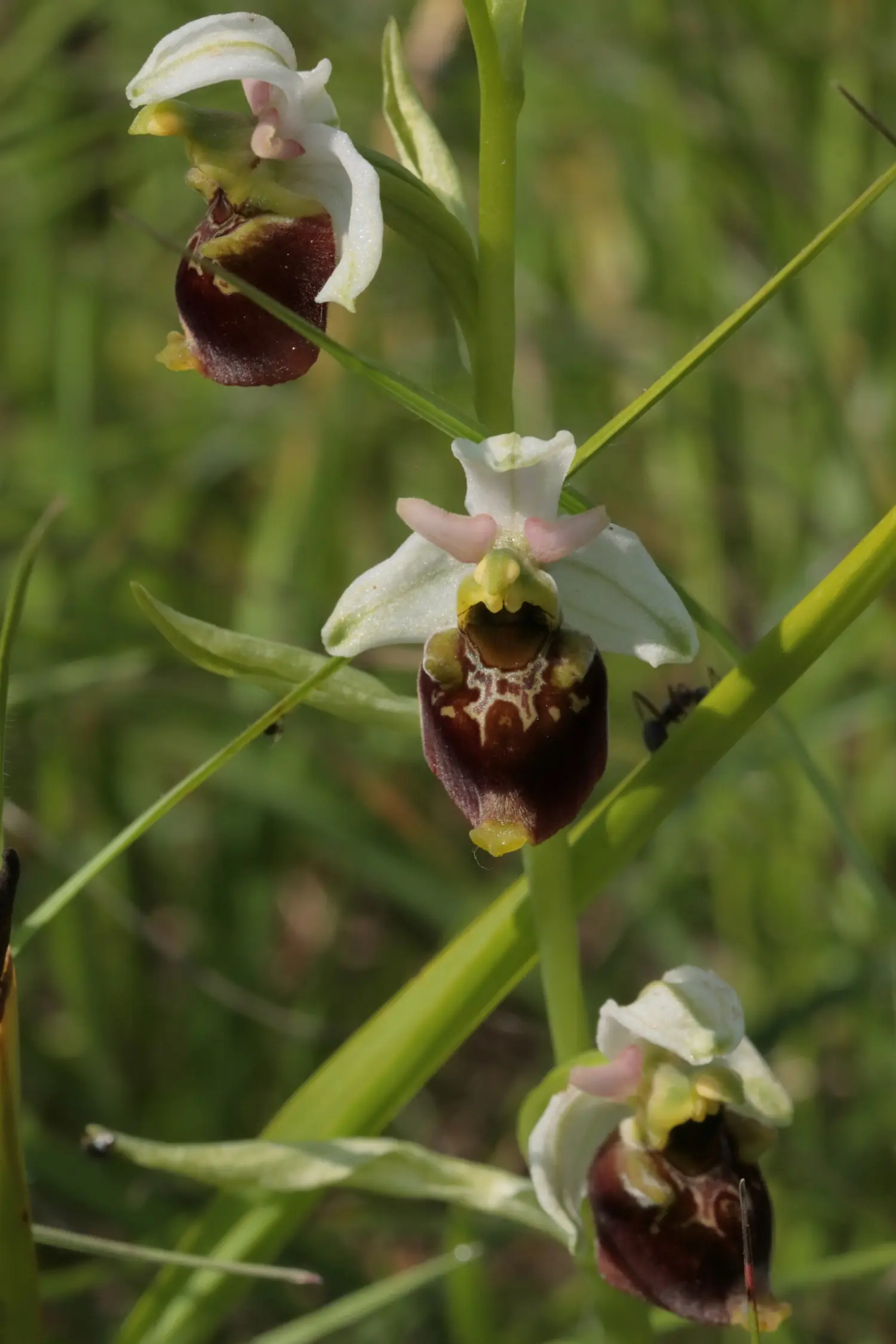The first time you see the late spider-orchid (Ophrys holoserica) is a special experience for many people. The shape of its flowers also makes it a very special orchid.




These pictures show the Lower Bavarian late spider-orchid from the Isar –
Occurrence and distribution: The late spider orchid can be found in nutrient-poor meadows, semi-arid grasslands and scrubby hillsides. It is sometimes found in open pine forests. Soil conditions for the plant should be moderately dry, but always chalky! It is a semi-alpine species. In the Alps it can be found up to 1,450 metres. The late spider-orchid is one of the characteristic species of the Molinion community (a dry plant community). In Europe, the plant is widespread in Mediterranean to sub-Mediterranean areas as far south as England. In Bavaria the main distribution centres are along the Danube and Lech rivers. Individual stands are also known in northern Bavaria and Lower Franconia. – AHO Bavaria.
Plant description
Growth habit: The late spider-orchid is an upright-growing, perennial, herbaceous plant. It can reach a height between 10 and 50 cm. A rhizome forms under the soil for the plant to hibernate. The stem is a light green colour and there are no glandular hairs.
Leaves: Leaves are arranged in a basal rosette close to the ground. The basal leaves are blue-green. Each stem has one or two bracts surrounding the stem. Below the flowers are further elongated, light green leaves. There is no distinct vein in the centre of the leaves (which is also green in colour).
Flowers: The flowers of the late spider-orchid sit in an elongated inflorescence at the end of the stem. The individual flowers are arranged alternately around the stem. There can be 2 to 10 flowers per inflorescence. The flowers can have quite different shapes and colours – see flower characteristics. The early subspecies flowers from the beginning of May to mid-June. The later subspecies can flower from July to August.
Fruits: The fruits of the plant are up to 15 mm long and up to 7 mm thick. They are greenish at first and turn brown when ripe. The upper surface is covered with light grooves. Due to the peculiar pollination conditions of the plant, the fruit set is small. Between 10,000 and 15,000 seeds can be produced per capsule (Salisbury 1942; Neiland 1994). When ripe, the capsule fruits open longitudinally downwards. The fruit ripens from mid-July.
Special features of the flower
Flower characteristics: The petals (larger petals) are elongated and egg-shaped with a blunt tip. The flowers can reach a diameter of between 2 and 3 cm. The three main petals are triangular in shape. The green leaf veins are visible in the centre. The smaller sepals (2 protruding petals) usually have an intense colour. All petals are covered with fine hairs.
The lower lip of the flower is clearly convex and has a ‘trapezoidal’ shape. At the lower edge of the lower lip there is a green appendage pointing forward. This ends in a point. The colour of the lower lip can vary from brown to dark red. The sap spot is very variable in colour. It consists of a white/greenish bordered basal spot, often in the shape of an “H”, and often smaller spots around the basal spot. The throat is surrounded by two other yellow-green appendages. The throat itself is dark brown to light brown and contains the pistils and stamens. The two stamens are at the top of the throat.
Special features of pollination
Pollination of the flowers: The flowers are pollinated by several species of long-horned bees. The flowers of the late spider orchid use a special trick to attract pollinators. The markings on the lip and an “insect pheromone” emitted by the flowers attract the males of the two long-horned bee species “Eucera nigrescens” and “Eucera longicornis” (PAULUS 2010). They mimic a female on a flower that is ready to mate. The male crawls onto the flower and is rewarded by having two pollinia attached to his head through the flower. The pollinia bend slightly downwards after flying out of the flower. When they visit the next flower, the pollen they contain is involuntarily deposited on the stigma. This is how the flower is pollinated. However, pollination is very rarely observed!
Folk names
Folk names: The late spider-orchid is known by various common names in Swabia and Baden. The Swabian names include, among others: “Totekopf (skull), Dodeköpfle (skull), Uracher Toteköpfle, Sammetmändle (velvet coat), Affegsicht (monkey face)” 1. In Baden, the plant is known as “Ochsenschühli” (Ox shoe) in the region around Ihringen. In Sitzenkirch it is called “Immli”. 2 The name “Dodeköpfle” (skull) is derived from the shape and colour of the flower. This is vaguely reminiscent of a skull on the lower lip. The name “Sammetmändle” is also related to the lower lip, as it is often short and hairy.
Where does the name “Uracher Toteköpfle” come from?
Uracher Toteköpfle: According to legend, after the humanist and freedom-loving poet Nicodemus Frischlin died in Bad Urach, a very special kind of late spider-orchid grew from his blood. Frischlin was imprisoned in Hohenurach Castle in 1590. He is said to have fallen into the castle moat during his escape attempt. The special late spider-orchid is said to have grown here ever since!
Origin of name
Name origin: The botanical genus name “Ophrys” is derived from the ancient Greek “ὀφρύς” (ophrys) – which also corresponds to the Greek name of the plant genus. This can be translated into English as “brow / eyebrow”. According to Helmut Genaust, this analogy is derived from the hairy lip of the flower. The botanical species name “holoserica” is composed of the Latin words “holo” – meaning “whole” and “sericeus” – meaning “silky-haired”. This also refers to the hairiness of the lip. 3
Endangerment of the plant
Endangerment of the plant: The late spider-orchid is already classified as endangered on the German Red List. The plant is protected under the EC Species Protection Regulation and CITES (Washington Convention on International Trade in Endangered Species of Wild Fauna and Flora) and thus it is not permitted to be removed from the wild! The individual endangerment levels in the federal states are as follows:
- Germany: endangered (status: 3)
- Baden-Württemberg: endangered (status: 3)
- Bavaria: Highly endangered (status: 2)
- Brandenburg: Extinct (Status: 0)
- Hesse: threatened with extinction (status: 1)
- Rhineland-Palatinate: highly endangered (status: 2)
- Saarland: pre-warning level (status: V)
Distribution codes: A, AV, M1 (partly), M2 (partly)
– Speaker’s note: It is impolite to address your classmates as “You Ragwurz” –
- Schwäbische Flora, Schwäbischer Albverein, S. 514 ↩︎
- Badische Volksnamen von Pflanzen IV von Walther Zimmermann ↩︎
- Taschenwörterbuch der botanischen Pflanzennamen, Franz Boerner ↩︎